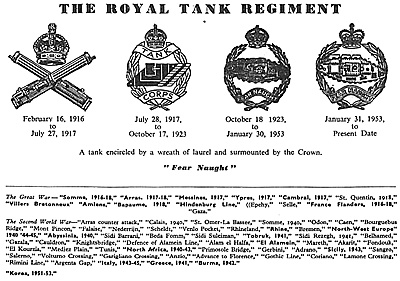KC
Looking back over the Regiment's history, today's tankmen think that of all our commanders General Broad probably had the most long lasting influence on the development of the tank formations. Next to General 'Hobo's', the face and name of General Broad is the most well known and remembered.
- Sir B L-H
I have told how G M Lindsay was the leading man in the first post-war decade, and it was he who secured Major C N F Broad, a very able young artilleryman, to take charge of the Tank Gunnery School in 1924, the year after the Permanent Tank Corps was created. Even the best artillery experts tended to take a limited view and limiting line in regard to tank operations. In the correspondence between Col Alan Brooke (later CIGS in the war), and Lindsay Broad show a keen foresight of his advanced line of thought in his contention that the design of an attack should be suited to the tanks, in order to makethe most of their powers.
Fortunately, Charles Broad went to the War Office in 1927, where he took over charge of SD2, the General Staff section directly concerned with the Army's organisation for war. While he could exert only an indirect influence on the conduct of the 'trials', his presence in such a key position was of great value in bringing experiments back to the original course whenever they wandered off itwhich happened frequently. I met him shortly afterwards, when we lunched at - he Army and Navy Club.
The Military Correspondent of the Daily Telegraph had been asking queitions about "An Army Mystery: Is there a Mechanical Force?", which had evidently nettled the War Office heads and it was evident that my visits to the War Office were to be placed under restrictions. After the exercise put on for Winston Churchill, about which I told you, I had a call from Charles Broad conveying an invitation from Field-Marshal Milne (the CIGS) to attend a lecture at Tidworth. So I drove back to Tidworth, in a deluge of rain, and arrived just in time. Broad had drafted the notes of his address to the senior officers of the Mechanised Force. But Milne put the draft into its final form and although the first draft embodied some points from Fuller and myself, I was delighted to see that the lecture not only endorsed the arguments for armoured mobility but went much farther than any of us had hoped.
A few months later, Milne and his chief assistants showed caution, and even doubt. Broad had been asked to give a lecture at the RUSI in November and his exposition was closely similar to the lines that Milne himself had'de!ivered in Tidworth. But in winding up, and thanking the lecturer, Milne disclaimed any responsibility for the sentiments which Broad had been expounding.
In March 1929 the War Office issued the first official manual on armoured warfare. The manual was drafted by Charles Broad, who asked me to visit the War Office for a conference on the day the booklet was to be issued. As I met him, Broad remarked: "You'll find a lot of LH in it". It was commonly called 'The Purple Primer~-a nickname suggested by the colour of the coven.
During the next two years Broad submitt:d reports suggesting the expansion of the RTC and ,a policy on reorganisation looking five years ahead'. So Broad proceeded to drat a plan for the creation of four armoured brigades of the pattern visualized in the Purple Primer.
KC
I have a copy of both the 'Purple Primer' ano a cutting from The Daily Telegraph dated November 1931 in which you wrote:
"The General Staff has recently produced and the Army Council has set its seal upon a text book of up-to-date warfare that heralds a new era in military methods and ideas. Styled: "Modern Formations", its sober and carefully weighed phrases do not conceal its revolutionary nature. It is enough to make the Duke of Cambridge turn in his grave, or to cause Mr H G Wells to revise his opinion of military authorities and their congenital blindness.
"Mechanisation is declared to be inevitable, and no longer a matter for choice. Even if the Army tarries in equipment, its mind must be trained and attuned to the new pattern with which it will certainly have to wage any future war. A repetition of the last and its methods would ruin our civilisation. The Army must regain mobility by mechanical means".
I remember a photograph of General Broad giving orders for 'brigade drill' from his special command tank to the 1st Brigade, Royal Tank Corps' during the 1931 exercises on Salisbury Plain. What is your comment on those famous manoeuvres?
To be continued...
Reproduced by permission of the Editor of the "TANK" Journal of the Royal Tank Regiment, and of Sgt. Ken Chadwick, RTR.

More Liddell-Hart Interview
- Prologue
Why Call It a "Tank" and not a "Landship?"
Ernest Swinton and the Development of the Tank
Lt-Gen Sir G le Q Martel
Major-General Sir Hugh J. Elles
Lieutenant General Sir Charles Broad, KCB, DSO
Back to Table of Contents -- Wargamer's Newsletter #146
To Wargamer's Newsletter List of Issues
To MagWeb Master Magazine List
© Copyright 1974 by Donald Featherstone.
This article appears in MagWeb (Magazine Web) on the Internet World Wide Web.
Other military history articles and gaming articles are available at http://www.magweb.com